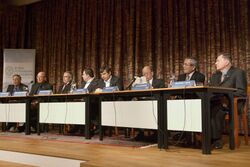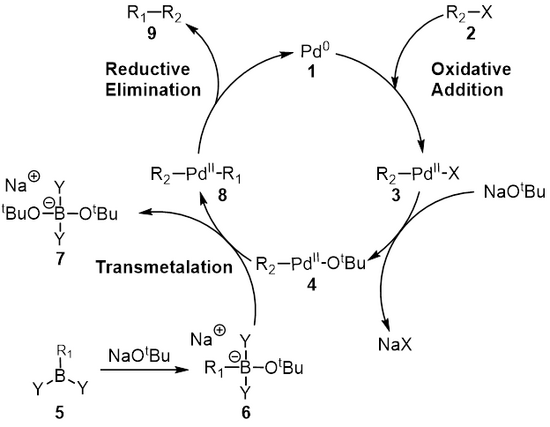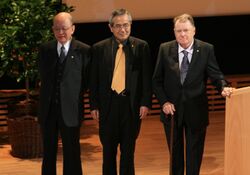أكيرا سوزوكي (كيميائي)
أكيرا سوزوكي Akira Suzuki | |
|---|---|
 | |
| وُلِدَ | 12 سبتمبر 1930 |
| القومية | ياباني |
| المدرسة الأم | جامعة هوكايدو |
| عـُرِف بـ | تفاعل سوزوكي |
| الجوائز | جائزة نوبل في الكيمياء (2010) Person of Cultural Merit (2010) Order of Culture (2010) |
| السيرة العلمية | |
| المجالات | الكيمياء |
| الهيئات | جامعة هوكايدو Purdue University University of Wales Okayama University of Science Kurashiki University of Science and the Arts |
| أثـَّر عليه | Herbert Charles Brown |
أكيرا سوزوكي Akira Suzuki (鈴木 章, Suzuki Akira, و. 12 سبتمبر, 1930) كيميائي ياباني فائز بجائزة نوبل في الكيمياء (2010)، أول من نشر تفاعل سوزوكي، الذي هو تفاعل عضوي لحمض الأريل- أو الڤاينيل-بورونيك مع هاليد لأريل أو لڤاينيل محفوزاً بمـُعـَقـَد الپلاديوم(0)، عام 1979.[1][2][3][4]
حياته
وُلد سوزوكي في 12 سبتمبر 1930 في موكاوا، هوكايدو، اليابان. وقد درس في جامعة هوكايدو، وبعد أن حصل على الدكتوراه منها، عمل في نفس الجامعة أستاذاً مساعداً.
السيرة
From 1963 until 1965, Suzuki worked as a postdoctoral student with Herbert C. Brown at Purdue University and after returning to the Hokudai he became a full professor there. The postdoctoral experience was utilized in the study of the coupling reaction with his assistant Norio Miyaura and led to the discovery of Suzuki reaction announced in 1979.[5] Its organic boronic acids with aryl and vinyl group are stable to water and air, easy to handle, and because the conditions required for use are also relatively mild, even among the several cross-coupling techniques, it is said to be easy to use.[6] Its full mechanism is shown in the image below.
With his retirement from Hokudai in 1994 he took several positions in other universities: 1994–1995 Okayama University of Science and 1995–2002 Kurashiki University of Science and the Arts.[7] In addition, he was an invited professor at Purdue University (2001), Academic Sinica and the National Taiwan University (2002).
In 2010, Suzuki was jointly awarded the Nobel Prize for Chemistry together with Richard F. Heck and Ei-ichi Negishi.[8]
To celebrate International Year of Chemistry (IYC 2011), Suzuki was interviewed by the UNESCO Courier magazine, he said:
Today some people see chemistry just as a polluting industry, but that is a mistake ... Without it, productivity would drop and we could not enjoy the life we know today. If there is pollution, it is because we are releasing harmful substances. Obviously, we have to adapt treatment and management regimes and work to develop chemical substances and manufacturing processes that respect the environment.[9]
In 2014, a Canadian-Chinese student asked for Suzuki's advice: "how can I become a great chemist like you?", Suzuki answered him: "... above all else, you must learn to see through the appearance to perceive the essence."[10]
اختراع بدون براءة اختراع
Suzuki has not obtained a patent on Suzuki reaction technology because he thinks that the research was supported by government funds,[11] therefore coupling technology has become widespread, and many products using this technology have been put into practical use.[12] To date, there are more than 6,000 papers and patents related to Suzuki reaction.[11]
الاعتراف به

- 1986 – Weissberger-Williams lectureship Award[13]
- 1987 – Korean Chemical Society Award
- 1989 – Chemical Society of Japan Award
- 1995 – DowElanco lectureship Award
- 2000 – The H. C. Brown Lecture Award
- 2003 – Japan Academy Prize
- 2009 – Paul Karrer Gold Medal
- 2009 – Special Member of Royal Society of Chemistry (RSC)
- 2010 – Nobel Prize in Chemistry
- 2010 – Order of Culture
- 2010 – Person of Cultural Merit
- 2011 – Member of the Japan Academy
- 2012 – Honorary Fellowships of RSC[14]
- 2016 – Honorary chair professorship, National Cheng Kung University[15]
انظر أيضاً
المصادر
- ^ Miyaura, N. et al. Tetrahedron Lett. 1979, 3437.
- ^ Miyaura, N.; Suzuki, A. Chem. Commun. 1979, 866.
- ^ Suzuki, A. Pure Appl. Chem. 1991, 63, 419-422. (Review)
- ^ Suzuki, A. J. Organometallic Chem. 1999, 576, 147–168. (Review)
- ^ 宮浦憲夫; 萬代忠勝 (2004). "辻二郎先生, 鈴木章先生日本学士院賞を受賞". 有機合成化学協会誌. 有機合成化学協会. 62 (5): 410. doi:10.5059/yukigoseikyokaishi.62.410. 和書.
- ^ "鈴木 章 Akira Suzuki | Chem-Station (ケムステ)". www.chem-station.com. Retrieved March 20, 2022.
- ^ Miyaura, Norio; Suzuki, Akira (1995). "Palladium-Catalyzed Cross-Coupling Reactions of Organoboron Compounds". Chemical Reviews. 95 (7): 2457–2483. doi:10.1021/cr00039a007.
- ^ "The Nobel Prize in Chemistry 2010" (Press release). Royal Swedish Academy of Sciences. October 6, 2010. Retrieved October 6, 2010.
- ^ http://unesdoc.unesco.org/images/0019/001906/190645e.pdf#nameddest=190724[bare URL PDF]
- ^ "聪明人的思维方式与普通人的区别有哪些? - 知乎". www.zhihu.com. Retrieved March 20, 2022.
- ^ أ ب 『朝日新聞』2010年10月7日
- ^ "根岸・鈴木氏、特許取得せず…栄誉の道開く一因". 読売新聞. October 7, 2010. Archived from the original on October 9, 2010. Retrieved October 8, 2010.
- ^ Akira Suzuki (in Japanese)
- ^ "Japanese Nobel Prize Chemists Honored By Royal Society Of Chemistry". Asian Scientist Magazine. June 12, 2012. Retrieved March 20, 2022.
- ^ "Nobel laureate Akira Suzuki receives honorary chair professorship from NCKU – NCKU, 國立成功大學 National Cheng Kung University". Archived from the original on September 27, 2017. Retrieved September 27, 2017.
- All articles with bare URLs for citations
- Articles with bare URLs for citations from March 2022
- Articles with PDF format bare URLs for citations
- Short description is different from Wikidata
- مواليد 12 سبتمبر
- مواليد 1930
- شهر الميلاد مختلف في ويكي بيانات
- يوم الميلاد مختلف في ويكي بيانات
- Portal templates with default image
- كيميائيون يابانيون
- حائزو جائزة نوبل يابانيون
- أشخاص من هوكايدو
- حائزو جائزة نوبل في الكيمياء


